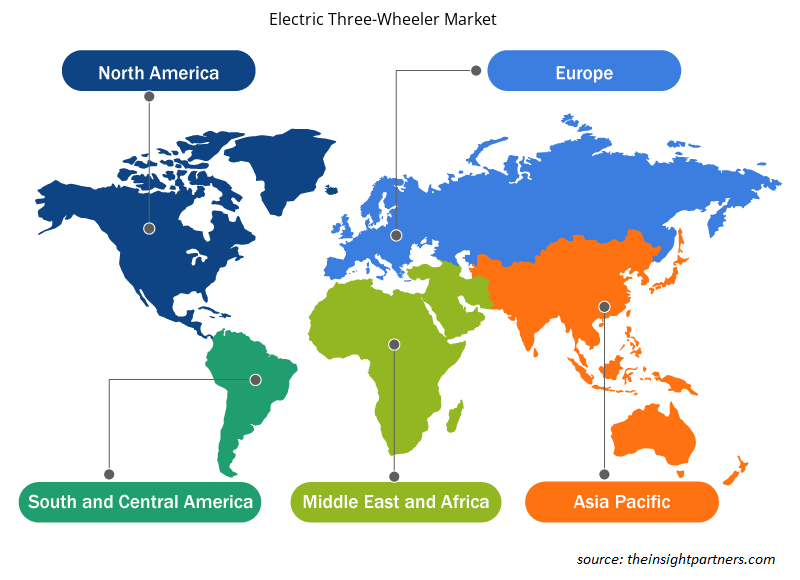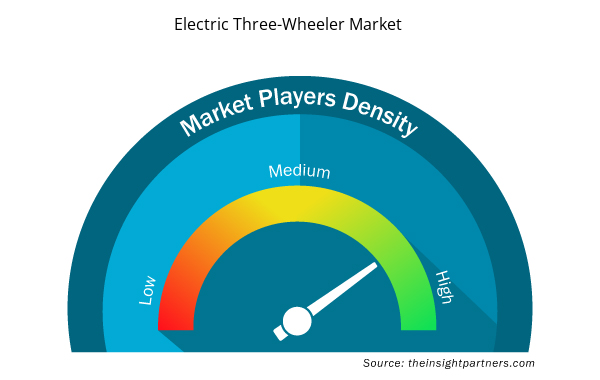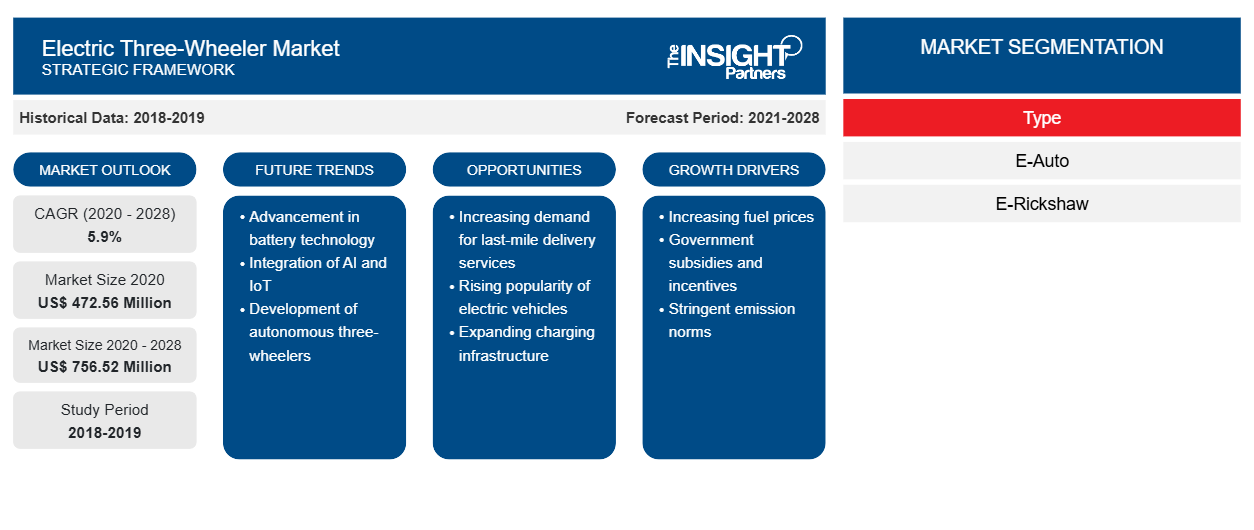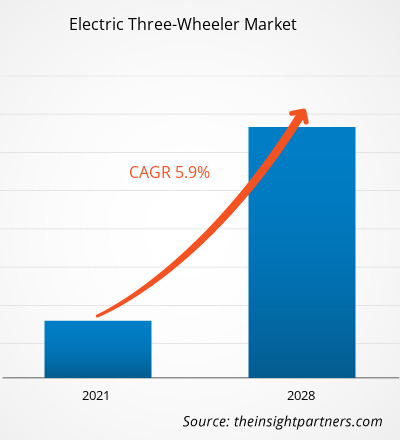Il mercato dei veicoli elettrici a tre ruote è stato valutato 472,56 milioni di dollari nel 2020 e si prevede che raggiungerà i 756,52 milioni di dollari entro il 2028; si prevede una crescita a un CAGR del 5,9% dal 2021 al 2028.
I veicoli elettrici a tre ruote sono ampiamente utilizzati per trasportare passeggeri alla destinazione desiderata e per il trasporto di merci. Questi veicoli a tre ruote funzionano con motori elettrici alimentati da batterie ricaricabili. Le batterie possono essere ricaricate presso una stazione di ricarica elettrica o qualsiasi altro punto di ricarica. Molti paesi a basso e medio reddito in tutto il mondo hanno un tasso di utilizzo più elevato di veicoli a tre ruote, inizialmente alimentati da motori a combustione interna (IC). Ma la maggior parte di questi veicoli a tre ruote con motore a combustione interna sono diventati inefficienti e vecchi. Ciò ha portato i produttori ad aumentare la spesa per la ricerca e lo sviluppo di veicoli elettrici a tre ruote. Inoltre, i veicoli elettrici a tre ruote sono molto popolari nelle aree urbane e suburbane, specialmente per trasportare un piccolo numero di passeggeri e merci compatte in un breve lasso di tempo. Alcuni dei fattori chiave che guidano la crescita del mercato dei veicoli elettrici a tre ruote sono le rigide norme e normative governative in materia di controllo dell'inquinamento, la crescente consapevolezza sugli effetti nocivi delle emissioni dei veicoli diesel e della benzina e la crescente accettazione dei veicoli elettrici. Poiché benzina e gasolio sono risorse esauribili, le persone hanno già iniziato a pensare ad altre possibili alternative. I veicoli elettrici a tre ruote hanno iniziato a sostituire i veicoli a tre ruote a benzina e diesel. Il costo medio di manutenzione e funzionamento dei veicoli elettrici a tre ruote è sostanzialmente inferiore rispetto ai veicoli a tre ruote convenzionali. Tuttavia, il pacco batteria pesante e la bassa autonomia di percorrenza sono alcune delle aree di preoccupazione affrontate dai produttori di veicoli elettrici a tre ruote. I veicoli elettrici a tre ruote coprono circa 125-130 km con la batteria completamente carica, mentre i veicoli convenzionali coprono circa 200-220 km con il serbatoio pieno di carburante.
L'APAC ha dominato il mercato dei veicoli elettrici a tre ruote nel 2020. L'India è uno dei maggiori azionisti del mercato dei veicoli elettrici a tre ruote nella regione. L'industria dei veicoli a basse emissioni nel paese sta crescendo rapidamente grazie alle iniziative favorevoli dei governi e alla solida presenza di produttori come Mahindra & Mahindra, Atul Auto, Piaggio e Lohia Auto. Il programma Faster Adoption and Manufacturing of Hybrid and Electric Vehicles II (FAME II), con un budget di 1,4 miliardi di USD, spenderebbe 1,19 miliardi di USD per consentire sconti iniziali sugli acquisti di veicoli elettrici e 1,9 milioni di USD per promuovere l'implementazione di infrastrutture di ricarica. Per soddisfare la domanda, queste misure andranno a beneficio di 0,5 milioni di veicoli elettrici a tre ruote.
Personalizza questo report in base alle tue esigenze
Riceverai la personalizzazione gratuita di qualsiasi report, comprese parti di questo report, o analisi a livello nazionale, pacchetto dati Excel, oltre a usufruire di grandi offerte e sconti per start-up e università
- Scopri le principali tendenze di mercato in questo rapporto.Questo campione GRATUITO includerà analisi di dati che spaziano dalle tendenze di mercato alle stime e alle previsioni.
Impatto della pandemia di COVID-19 sul mercato dei veicoli elettrici a tre ruote
L'epidemia di COVID-19 ha gravemente interrotto la catena di fornitura e la produzione di apparecchiature elettroniche, compresi i componenti hardware dei veicoli elettrici a tre ruote. Sulla base dell'emergere del virus COVID-19 in tutto il mondo, seguito da scenari di blocco, gli esperti del settore automobilistico hanno previsto che il settore avrebbe dovuto affrontare almeno un quarto di ritardo nella catena di fornitura di apparecchiature elettroniche. È probabile che l'industria delle apparecchiature elettroniche e automobilistica riprenda ritmo subito dopo che i governi avranno revocato le varie misure di contenimento, il che aiuterebbe a rilanciare le economie. Si prevede che la produzione di apparecchiature elettroniche e prodotti automobilistici aumenterà di ritmo dal 2021, il che dovrebbe ulteriormente influenzare positivamente l'attrezzatura elettronica e la produzione automobilistica, compresi i componenti hardware dei veicoli elettrici a tre ruote.
Approfondimenti di mercato
Aumento del livello di gas nocivi, gestione dei costi e accettazione di tecnologie più pulite
L'aumento dei livelli di gas nocivi, la gestione dei costi e l'accettazione di tecnologie più pulite sono tra i principali fattori che contribuiscono alla crescita del mercato dei veicoli elettrici a tre ruote. L'adozione di veicoli elettrici può ridurre drasticamente le emissioni di inquinanti nell'ambiente, migliorando così la qualità dell'aria. Per ridurre al minimo le emissioni di gas serra tramite la combustione di carburante per veicoli, gli enti normativi in tutto il mondo stanno offrendo agevolazioni fiscali e incentivi per aumentare l'adozione di veicoli ecologici. Quasi tutti i principali paesi hanno annunciato sussidi e incentivi finanziari per attrarre i produttori a produrre più veicoli elettrici a livello locale. Inoltre, crediti d'imposta e rimborsi stanno attraendo molti utenti locali ad acquistare veicoli elettrici e probabilmente porteranno almeno circa il 60% di veicoli ecologici su strada entro il 2020, riducendo così le emissioni di carburante e diminuendo la dipendenza dai prodotti petroliferi. Gli enti normativi di Cina, India, Corea del Sud, Indonesia e Bangladesh hanno implementato vari programmi per aumentare le vendite di veicoli elettrici a tre ruote. Ad esempio, a marzo 2018, il Ministero dell'industria pesante e delle imprese pubbliche dell'India ha lanciato la Fase II del FAME India Scheme, che ha ricevuto un sostegno di bilancio totale di 1,39 miliardi di dollari. Questa fase mira a supportare 500.000 veicoli elettrici a tre ruote; 55.000 autovetture elettriche a quattro ruote; 7.000 e-bus; e 100.000 veicoli elettrici a due ruote tramite sussidi. Questa fase del FAME Scheme mira a stabilire un'adeguata infrastruttura di ricarica pubblica per aumentare l'adozione di veicoli elettrici tra le masse. Con questo, il Ministero dell'industria pesante e delle imprese pubbliche prevede il coinvolgimento e la partecipazione attiva di un'ampia gamma di parti interessate, tra cui le imprese del settore pubblico (PSE) e le agenzie governative.
Approfondimenti di mercato basati sul tipo
Il mercato dei veicoli elettrici a tre ruote, per tipo, è segmentato in e-auto (alta velocità) ed e-rickshaw (bassa velocità). Il segmento e-rickshaw ha guidato il mercato nel 2020. Gli e-rickshaw sono veicoli elettrici a tre ruote sottoalimentati e hanno capacità di batteria inferiori rispetto agli e-auto.
Gli sviluppi di prodotto e le iniziative di mercato sono le strategie comunemente adottate dalle aziende per espandere il loro portafoglio prodotti. Piaggio & C. SpA, Terra Motors Corporation, Kinetic Green Energy & Power Solutions Ltd., LOHIA AUTO INDUSTRIES e Mahindra Electric Mobility Limited sono tra i principali attori che implementano strategie per ampliare la base clienti e ottenere una quota significativa nel mercato globale dei veicoli elettrici a tre ruote, il che, a sua volta, consente loro di mantenere il loro marchio. Di seguito sono menzionati alcuni dei recenti sviluppi chiave:
- Nell'ottobre 2020, Mahindra Electric Mobility Ltd ha annunciato il lancio del suo nuovo modello di cargo elettrico a 3 ruote, Treo Zor, in India. Basato sulla collaudata piattaforma Treo, il cargo sarebbe stato fornito in 3 varianti: Pickup, Delivery Van e Flat Bed.
- Nel febbraio 2018, Mahindra & Mahindra Ltd e LG Chem hanno annunciato una collaborazione nel campo della tecnologia avanzata delle batterie agli ioni di litio.
Approfondimenti regionali sul mercato dei veicoli elettrici a tre ruote
Le tendenze regionali e i fattori che influenzano il mercato dei veicoli elettrici a tre ruote durante il periodo di previsione sono stati ampiamente spiegati dagli analisti di Insight Partners. Questa sezione discute anche i segmenti e la geografia del mercato dei veicoli elettrici a tre ruote in Nord America, Europa, Asia Pacifico, Medio Oriente e Africa e America meridionale e centrale.

- Ottieni i dati specifici regionali per il mercato dei veicoli elettrici a tre ruote
Ambito del rapporto sul mercato dei veicoli elettrici a tre ruote
| Attributo del report | Dettagli |
|---|---|
| Dimensioni del mercato nel 2020 | 472,56 milioni di dollari USA |
| Dimensioni del mercato entro il 2028 | 756,52 milioni di dollari USA |
| CAGR globale (2020 - 2028) | 5,9% |
| Dati storici | 2018-2019 |
| Periodo di previsione | 2021-2028 |
| Segmenti coperti | Per tipo
|
| Regioni e Paesi coperti | America del Nord
|
| Leader di mercato e profili aziendali chiave |
|
Densità degli operatori del mercato dei veicoli elettrici a tre ruote: comprendere il suo impatto sulle dinamiche aziendali
Il mercato dei veicoli elettrici a tre ruote sta crescendo rapidamente, spinto dalla crescente domanda degli utenti finali dovuta a fattori quali l'evoluzione delle preferenze dei consumatori, i progressi tecnologici e una maggiore consapevolezza dei vantaggi del prodotto. Con l'aumento della domanda, le aziende stanno ampliando le loro offerte, innovando per soddisfare le esigenze dei consumatori e capitalizzando sulle tendenze emergenti, il che alimenta ulteriormente la crescita del mercato.
La densità degli operatori di mercato si riferisce alla distribuzione di aziende o società che operano in un particolare mercato o settore. Indica quanti concorrenti (operatori di mercato) sono presenti in un dato spazio di mercato in relazione alle sue dimensioni o al valore di mercato totale.
Le principali aziende che operano nel mercato dei veicoli elettrici a tre ruote sono:
- Veicoli elettrici a motore Goenka Private Limited
- Piaggio & C. SpA
- Società di motori Terra
- Kinetic Green Energy & Power Solutions Ltd.
- INDUSTRIA AUTOMOBILISTICA DI LOHIA
Disclaimer : le aziende elencate sopra non sono classificate secondo un ordine particolare.

- Ottieni una panoramica dei principali attori del mercato dei veicoli elettrici a tre ruote
Segmentazione del mercato dei veicoli elettrici a tre ruote:
Per tipo
- E-Auto (alta velocità)
- E-Rickshaw (bassa velocità)
Profili aziendali
- Veicoli elettrici a motore Goenka Private Limited
- Piaggio & C. SpA
- Società di motori Terra
- Kinetic Green Energy & Power Solutions Ltd.
- INDUSTRIA AUTOMOBILISTICA DI LOHIA
- Gruppo Veicoli Bodo Co. Ltd.
- Auto Nobe
- Mahindra Electric Mobility Limited
- Fabbrica E-Tuk BV
- JIANGSU KINGBON VEICOLO CO., LTD
- Analisi storica (2 anni), anno base, previsione (7 anni) con CAGR
- Analisi PEST e SWOT
- Valore/volume delle dimensioni del mercato - Globale, regionale, nazionale
- Industria e panorama competitivo
- Set di dati Excel



Report Coverage
Revenue forecast, Company Analysis, Industry landscape, Growth factors, and Trends

Segment Covered
This text is related
to segments covered.

Regional Scope
North America, Europe, Asia Pacific, Middle East & Africa, South & Central America

Country Scope
This text is related
to country scope.
Domande frequenti
E-rickshaws are under-powered electric three-wheeler vehicles, and they have lower battery capacities compared to e-auto. These parameters contribute to the lower range, lower speed, and lower payload capacity of e-rickshaws. The e-rickshaws are mainly in use in developing countries in Asia Pacific, especially in India. The e-rickshaws have the highest speed limit of 50 kmph with a maximum range of up to 70–80 km. Piaggio Vehicles Private Limited offers e-rickshaws based on swappable battery concept that helps used to overcome challenges such as high-cost battery replacement, low battery life, and charging infrastructure inadequacy. The Apé E-City offered by Piaggio Vehicles Private Limited allows users to swap batteries at company’s recharge station. E-rikshaws are further categorized as people carriers, goods carriers, and special vehicles.
Filtering through congested traffic in various metro cities is attained with great difficulty and sometime may end up in collisions while travelling in conventional vehicles. Passengers are likely to opt for small three-wheeler vehicles for their daily commute as means of public transport owing to its ease of maneuverability. Moreover, huge public transport vehicles such as buses, as well as taxis, cannot reach every location, especially when the destination is in remote area. Moreover, time required for arriving at the destination is substantially reduced owing to the small size of three-wheelers.
Companies are trying to invest more on R&D activities for embedding latest technologies, such as global positioning system (GPS) for navigation and solar-powered engines to derive electric power for the functioning of electric three-wheelers. GPS suggests best route available to the destination and also saves a considerable amount of time. Further, it shows traffic status on alternative routes along with estimated time to reach the location. Omega Seiki Mobility expanded its electric three-wheeler range in November 2020 with the introduction of three new smart EVs aimed at both the B2B and B2C segments. Omega Seiki's new electric vehicle line includes simulation software, telematics, and a GPS system.
The List of Companies - Electric Three-Wheeler Market
- Goenka Electric Motor Vehicles Private Limited
- Piaggio & C. SpA
- Terra Motors Corporation
- Kinetic Green Energy & Power Solutions Ltd.
- LOHIA AUTO INDUSTRIES
- Bodo Vehicle Group Co. Ltd.
- Nobe Cars
- Mahindra Electric Mobility Limited
- E-Tuk Factory BV
- JIANGSU KINGBON VEHICLE CO., LTD
The Insight Partners performs research in 4 major stages: Data Collection & Secondary Research, Primary Research, Data Analysis and Data Triangulation & Final Review.
- Data Collection and Secondary Research:
As a market research and consulting firm operating from a decade, we have published and advised several client across the globe. First step for any study will start with an assessment of currently available data and insights from existing reports. Further, historical and current market information is collected from Investor Presentations, Annual Reports, SEC Filings, etc., and other information related to company’s performance and market positioning are gathered from Paid Databases (Factiva, Hoovers, and Reuters) and various other publications available in public domain.
Several associations trade associates, technical forums, institutes, societies and organization are accessed to gain technical as well as market related insights through their publications such as research papers, blogs and press releases related to the studies are referred to get cues about the market. Further, white papers, journals, magazines, and other news articles published in last 3 years are scrutinized and analyzed to understand the current market trends.
- Primary Research:
The primarily interview analysis comprise of data obtained from industry participants interview and answers to survey questions gathered by in-house primary team.
For primary research, interviews are conducted with industry experts/CEOs/Marketing Managers/VPs/Subject Matter Experts from both demand and supply side to get a 360-degree view of the market. The primary team conducts several interviews based on the complexity of the markets to understand the various market trends and dynamics which makes research more credible and precise.
A typical research interview fulfils the following functions:
- Provides first-hand information on the market size, market trends, growth trends, competitive landscape, and outlook
- Validates and strengthens in-house secondary research findings
- Develops the analysis team’s expertise and market understanding
Primary research involves email interactions and telephone interviews for each market, category, segment, and sub-segment across geographies. The participants who typically take part in such a process include, but are not limited to:
- Industry participants: VPs, business development managers, market intelligence managers and national sales managers
- Outside experts: Valuation experts, research analysts and key opinion leaders specializing in the electronics and semiconductor industry.
Below is the breakup of our primary respondents by company, designation, and region:

Once we receive the confirmation from primary research sources or primary respondents, we finalize the base year market estimation and forecast the data as per the macroeconomic and microeconomic factors assessed during data collection.
- Data Analysis:
Once data is validated through both secondary as well as primary respondents, we finalize the market estimations by hypothesis formulation and factor analysis at regional and country level.
- Macro-Economic Factor Analysis:
We analyse macroeconomic indicators such the gross domestic product (GDP), increase in the demand for goods and services across industries, technological advancement, regional economic growth, governmental policies, the influence of COVID-19, PEST analysis, and other aspects. This analysis aids in setting benchmarks for various nations/regions and approximating market splits. Additionally, the general trend of the aforementioned components aid in determining the market's development possibilities.
- Country Level Data:
Various factors that are especially aligned to the country are taken into account to determine the market size for a certain area and country, including the presence of vendors, such as headquarters and offices, the country's GDP, demand patterns, and industry growth. To comprehend the market dynamics for the nation, a number of growth variables, inhibitors, application areas, and current market trends are researched. The aforementioned elements aid in determining the country's overall market's growth potential.
- Company Profile:
The “Table of Contents” is formulated by listing and analyzing more than 25 - 30 companies operating in the market ecosystem across geographies. However, we profile only 10 companies as a standard practice in our syndicate reports. These 10 companies comprise leading, emerging, and regional players. Nonetheless, our analysis is not restricted to the 10 listed companies, we also analyze other companies present in the market to develop a holistic view and understand the prevailing trends. The “Company Profiles” section in the report covers key facts, business description, products & services, financial information, SWOT analysis, and key developments. The financial information presented is extracted from the annual reports and official documents of the publicly listed companies. Upon collecting the information for the sections of respective companies, we verify them via various primary sources and then compile the data in respective company profiles. The company level information helps us in deriving the base number as well as in forecasting the market size.
- Developing Base Number:
Aggregation of sales statistics (2020-2022) and macro-economic factor, and other secondary and primary research insights are utilized to arrive at base number and related market shares for 2022. The data gaps are identified in this step and relevant market data is analyzed, collected from paid primary interviews or databases. On finalizing the base year market size, forecasts are developed on the basis of macro-economic, industry and market growth factors and company level analysis.
- Data Triangulation and Final Review:
The market findings and base year market size calculations are validated from supply as well as demand side. Demand side validations are based on macro-economic factor analysis and benchmarks for respective regions and countries. In case of supply side validations, revenues of major companies are estimated (in case not available) based on industry benchmark, approximate number of employees, product portfolio, and primary interviews revenues are gathered. Further revenue from target product/service segment is assessed to avoid overshooting of market statistics. In case of heavy deviations between supply and demand side values, all thes steps are repeated to achieve synchronization.
We follow an iterative model, wherein we share our research findings with Subject Matter Experts (SME’s) and Key Opinion Leaders (KOLs) until consensus view of the market is not formulated – this model negates any drastic deviation in the opinions of experts. Only validated and universally acceptable research findings are quoted in our reports.
We have important check points that we use to validate our research findings – which we call – data triangulation, where we validate the information, we generate from secondary sources with primary interviews and then we re-validate with our internal data bases and Subject matter experts. This comprehensive model enables us to deliver high quality, reliable data in shortest possible time.


 Ottieni un campione gratuito per questo repot
Ottieni un campione gratuito per questo repot